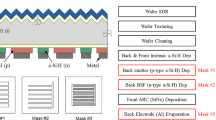Abstract
We report the current status of the development of our new detectors for far-infrared (FIR) astronomy. We develop Blocked-Impurity-Band (BIB)-type Ge detectors to realize large-format compact arrays covering a wide FIR wavelength range up to 200 \(\upmu \)m. We fabricated Ge junction devices of different physical parameters with a BIB-type structure, using the room temperature, surface-activated wafer bonding (SAB) method. We measured the absolute responsivity and the spectral response curve of each device at low temperatures, using an internal blackbody source in a cryostat and a Fourier transform spectrometer, respectively. The results show that the SAB Ge junction devices have significantly higher absolute responsivities and longer cut-off wavelengths of the spectral response than the conventional bulk Ge:Ga device. Based upon the results, we discuss the optimum parameters of SAB Ge junction devices for FIR detectors. We conclude that SAB Ge junction devices possess a promising applicability to next-generation FIR detectors covering wavelengths up to \(\sim \)200 \(\upmu \)m with high responsivity. As a next step, we plan to fabricate a BIB-type Ge array device in combination with a low-power cryogenic readout integrated circuit.


Similar content being viewed by others
References
Y. Doi et al., Exp. Astron. 10, 393–401 (2000)
M. D. Petroff and M. G. Stapelbroek, U.S. Patent 4568960 (1986)
H. Kaneda et al., Jpn. J. Appl. Phys. 50, 066503 (2011)
D.M. Watson, J.E. Huffman, Appl. Phys. Lett. 52, 1602 (1988)
H. Takagi et al., Appl. Phys. Lett 68, 2222 (1996)
H. Takagi, R. Maeda, J. Cryst. Growth 292, 429 (2006)
K. Watanabe et al., Jpn. J. Appl. Phys. 50, 015701 (2011)
T. Suzuki et al., Publ. Astron. Soc. Pac. 124, 823 (2012)
H. Nagata et al., AIP Conf. Proc. 1185, 267 (2009)
T. Wada et al., J. Low. Temp. Phys 167, 602 (2012)
K. Nagase et al., J. Low. Temp. Phys. This Special Issue
T. Wada et al., J. Low. Temp. Phys. This Special Issue. doi:10.1007/s10909-015-1393-8
Acknowledgments
This work was supported by JSPS KAKENHI Grant Numbers 20244016, 25109005, and 25247020. The authors are grateful to Mitsubishi Heavy Industries for their technical support in the surface-activated wafer bonding.
Author information
Authors and Affiliations
Corresponding author
Rights and permissions
About this article
Cite this article
Hanaoka, M., Kaneda, H., Oyabu, S. et al. Development of Blocked-Impurity-Band-Type Ge Detectors Fabricated with the Surface-Activated Wafer Bonding Method for Far-Infrared Astronomy. J Low Temp Phys 184, 225–230 (2016). https://doi.org/10.1007/s10909-016-1484-1
Received:
Accepted:
Published:
Issue Date:
DOI: https://doi.org/10.1007/s10909-016-1484-1




